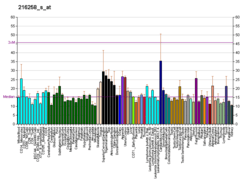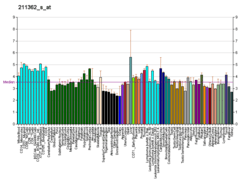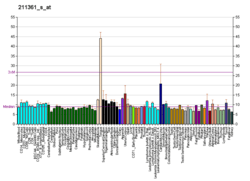SERPINB13
Serpin B13 is a protein that in humans is encoded by the SERPINB13 gene.[4][5][6]
See also
References
- 1 2 3 GRCm38: Ensembl release 89: ENSMUSG00000048775 - Ensembl, May 2017
- ↑ "Human PubMed Reference:".
- ↑ "Mouse PubMed Reference:".
- ↑ Abts HF, Breuhahn K, Michel G, Kohrer K, Esser P, Ruzicka T (Oct 1997). "Analysis of UVB-modulated gene expression in human keratinocytes by mRNA differential display polymerase chain reaction". Photochem Photobiol. 66 (3): 363–7. doi:10.1111/j.1751-1097.1997.tb03159.x. PMID 9297979.
- ↑ Abts HF, Welss T, Mirmohammadsadegh A, Kohrer K, Michel G, Ruzicka T (Nov 1999). "Cloning and characterization of hurpin (protease inhibitor 13): A new skin-specific, UV-repressible serine proteinase inhibitor of the ovalbumin serpin family". J Mol Biol. 293 (1): 29–39. doi:10.1006/jmbi.1999.3159. PMID 10512713.
- ↑ "Entrez Gene: SERPINB13 serpin peptidase inhibitor, clade B (ovalbumin), member 13".
Further reading
- Spring P, Nakashima T, Frederick M, et al. (1999). "Identification and cDNA cloning of headpin, a novel differentially expressed serpin that maps to chromosome 18q". Biochem. Biophys. Res. Commun. 264 (1): 299–304. doi:10.1006/bbrc.1999.1453. PMID 10527881.
- Nakashima T, Pak SC, Silverman GA, et al. (2000). "Genomic cloning, mapping, structure and promoter analysis of HEADPIN, a serpin which is down-regulated in head and neck cancer cells". Biochim. Biophys. Acta. 1492 (2–3): 441–6. doi:10.1016/s0167-4781(00)00100-7. PMID 11004515.
- Abts HF, Welss T, Scheuring S, et al. (2001). "Sequence, organization, chromosomal localization, and alternative splicing of the human serine protease inhibitor gene hurpin (PI13) which is upregulated in psoriasis". DNA Cell Biol. 20 (3): 123–31. doi:10.1089/104454901300068924. PMID 11313015.
- Strausberg RL, Feingold EA, Grouse LH, et al. (2003). "Generation and initial analysis of more than 15,000 full-length human and mouse cDNA sequences". Proc. Natl. Acad. Sci. U.S.A. 99 (26): 16899–903. doi:10.1073/pnas.242603899. PMC 139241. PMID 12477932.
- Jayakumar A, Kang Y, Frederick MJ, et al. (2003). "Inhibition of the cysteine proteinases cathepsins K and L by the serpin headpin (SERPINB13): a kinetic analysis". Arch. Biochem. Biophys. 409 (2): 367–74. doi:10.1016/S0003-9861(02)00635-5. PMID 12504904.
- Welss T, Sun J, Irving JA, et al. (2003). "Hurpin is a selective inhibitor of lysosomal cathepsin L and protects keratinocytes from ultraviolet-induced apoptosis". Biochemistry. 42 (24): 7381–9. doi:10.1021/bi027307q. PMID 12809493.
- Gerhard DS, Wagner L, Feingold EA, et al. (2004). "The Status, Quality, and Expansion of the NIH Full-Length cDNA Project: The Mammalian Gene Collection (MGC)". Genome Res. 14 (10B): 2121–7. doi:10.1101/gr.2596504. PMC 528928. PMID 15489334.
- Moussali H, Bylaite M, Welss T, et al. (2005). "Expression of hurpin, a serine proteinase inhibitor, in normal and pathological skin: overexpression and redistribution in psoriasis and cutaneous carcinomas". Exp. Dermatol. 14 (6): 420–8. doi:10.1111/j.0906-6705.2005.00300.x. PMID 15885077.
- Shellenberger TD, Mazumdar A, Henderson Y, et al. (2006). "Headpin: a serpin with endogenous and exogenous suppression of angiogenesis". Cancer Res. 65 (24): 11501–9. doi:10.1158/0008-5472.CAN-05-2262. PMID 16357159.
- Bylaite M, Moussali H, Marciukaitiene I, et al. (2006). "Expression of cathepsin L and its inhibitor hurpin in inflammatory and neoplastic skin diseases". Exp. Dermatol. 15 (2): 110–8. doi:10.1111/j.1600-0625.2005.00389.x. PMID 16433682.
External links
- The MEROPS online database for peptidases and their inhibitors: I04.017
- SERPINB13+protein,+human at the US National Library of Medicine Medical Subject Headings (MeSH)
This article incorporates text from the United States National Library of Medicine, which is in the public domain.
This article is issued from
Wikipedia.
The text is licensed under Creative Commons - Attribution - Sharealike.
Additional terms may apply for the media files.




